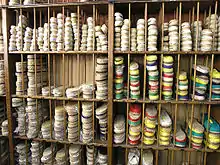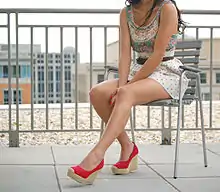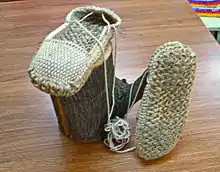Rope-soled shoe
Rope-soled shoes have soles (and possibly other parts) made from rope or rope fibres. They were formerly a cheap, disposable, hand-made item. However, the widely made espadrille comes in many styles and can include expensive fashion items.

Espadrille
Espadrilles are traditional rope-soled shoes originating in the Pyrenees region of France and Spain. They typically have a sandal-like form with woven straps or else a canvas upper. They were originally made from woven esparto (hence the name), but modern mass-produced shoes are more commonly made from the cheaper jute giving the modern shoe a distinctive bright white colour. Espadrilles are now made in many countries including France, Spain, Italy, and many South American countries. Typically though, manufacturers import pre-made rope soles from Bangladesh, a major source of jute, with the finishing and styling taking place in the local country.[1]


Bast shoe

Bast shoes are made from bast fibres. They were traditional shoes of the peoples of the taiga forests of northern Europe and Russia. Bast shoes were an item worn by the rural poor; leather was preferred in cities. Bast shoes were time consuming to make. The bark from three or four saplings were soaked in a press for a long period. Despite this, the shoes were somewhat disposable, only lasting a week or so.[2] Bast shoes were used until the mid-twentieth century. They did not always have a rope-like sole as in the picture. Perhaps more commonly they were crudely woven strips of bark.[3]
Maritime use
Disposable working shoes very similar to espadrilles were at one time worn by sailors, particularly in hot regions. They were hand made on board ship by each sailor individually. The soles and straps were made by the plaiting technique of sennit using rope yarns. Rope and canvas were materials readily available on sailing ships. The practice was definitely still current in the 1940s and may have continued into the 1960s in some places.[4]
References
- Glenn Surabian, Yauo Konishi, "Light manufacturing: non-leather footwear", ch. 4 in, Sanjay Kathuria, Mariem Mezghenni Malouche (eds), Attracting Investmnet in Bangladesh, World Bank Publications, 2016 ISBN 1464809259
- Natalia Pushkareva, Eve Levin (trans.), Women in Russian History: From the Tenth to the Twentieth Century, p. 59, M.E. Sharpe, 1997 ISBN 0765632705
- E.A. Solentsova, M.V. Krzyzewski, A.A Kapitonov, "Analysis of ethnic tourism resources and content placement", pp. 219–234 (p. 228) in, Svetlana Igorevna Ashmarina, Valentina Vyacheslavovna Mantulenko (eds), Current Achievements, Challenges and Digital Chances of Knowledge Based Economy, p. 228, Springer Nature, 2020 ISBN 3030474585.
- "Rope soled canvas shoes", Accession number 1984.327, National Museums Liverpool, archived from the original 2 August 2012.